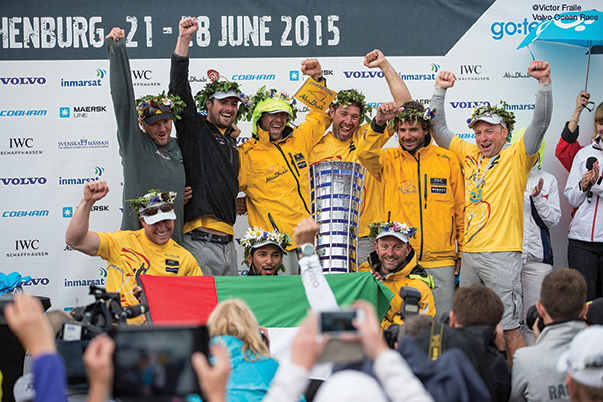The 2014-2015 Volvo Ocean Race was the most exciting and closely fought edition of this round-the-world classic (published August 2015)
It’s hard to imagine a more choreographed ending to what has truly been an exciting and nail biting event. The twelfth edition of the Volvo Ocean Race (originally named the Whitbread Round the World Race) is now in the history books and most would agree that it was the most successful race ever. From some incredibly close finishes, some high drama deep in the Southern Ocean when the Chinese boat Dongfeng dismasted, to a gut wrenching grounding on an Indian Ocean atoll by Team Vestus Wind, this race offered up more drama than anyone could have anticipated. Many, myself included, will be feeling withdrawal symptoms for weeks to come as we gaze longingly at our computers and phones looking for updates, but coming up empty.
THE NEW VOR
The real success of the event started three years earlier when the Volvo Ocean Race CEO Knut Frostad announced that the following two editions of the race would be held in one design boats. It was a difficult and at the time controversial decision that was met with some derision by the sailing public. How could the most prestigious offshore ocean race in the world downsize to smaller boats was the main criticism.
But Frostad knew that in order to get enough entries to make it a viable race he had to rein in costs and the smaller one design boats would be the key. In previous races, the cost of a single entry had soared to the tens of millions of dollars and the boats were immediately made redundant as soon as they crossed the finish line. The arc that the event was on was simply not sustainable and so the decision was made. Looking back one can only agree that it was the right decision.
Shortly after the dust settled on the one design announcement, Frostad and the event were tossed a massive bone when the Swedish company SCA, a leading global hygiene and forest products company, announced that they would back an all-female entry in the race. SCA were not short of cash and the buzz that would surround their entry would be good for all other potential competitors.
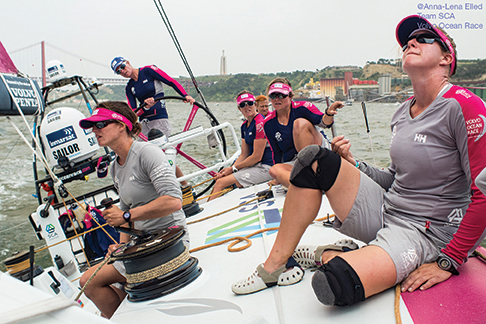
There had not been an all-women entry in the race for well over a decade and the idea of a well-funded, well-run team of inspired women was a major boost. Indeed Team SCA seemed to dominate the PR race even though their performance on the water was a little off the pace.
The one design and the SCA announcement were leveraged by some additional changes to the event. To make up for the fact that females lack brawn when compared to their male counterparts, Team SCA were allowed to race with 11 crew on board, three more than the male teams. Each boat would also carry a multimedia reporter whose sole job would be to tell the stories from onboard as the race unfolded. The stunning images and video segments that were sent from the middle of the ocean really galvanized a dedicated following of sailors and non-sailors alike. The onboard reporters honed their skills as drone pilots and captured some incredible aerial videos and for the first time ever we were able to see footage from off the boats as they sailed thousands of miles from land.
And then there was an announcement that each team had to race with two crew members born after October 1, 1984. They were called the “Under 30s” and the idea was to bring new blood into the race. It didn’t hurt that they also played well to a younger audience.
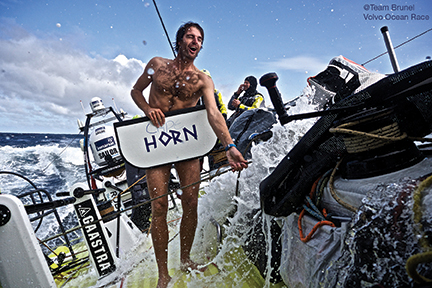
By the summer of 2013, the event looked to be shaping up and it was speculated that there would be seven entries. The Dutch were back with Team Brunel, their skipper Bouwe Bekking seeking to complete his seventh race. Abu Dhabi Ocean Racing were also back with British Olympic medalist Ian Walker seeking the first ever win for a U.K. skipper. Vestus, the Danish wind turbine manufacturer announced that Kiwi Chris Nicholson would skipper Team Vestus Wind, while long time sailing partners Iker Martínez and Xabi Fernández announced that they would compete on Mapfre and represent Spain.
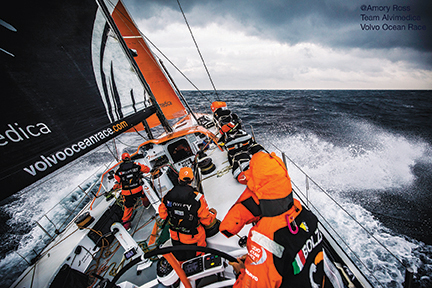
One of the last teams to enter was a serendipitous coming together of an ambitious syndicate led by American Charlie Enright and the Turkish company Alvimedica, which was looking to sponsor a boat. In the previous Volvo Ocean race there had been a Chinese entry and although well funded they did poorly largely due to lack of experience so when it was announced that there would be another Chinese entry, the news was met with some skepticism. The skepticism was tempered a little when it was made clear that only half the crew would be Chinese and that the boat would be skippered by the soft spoken Frenchman Charles Caudrelier. Those of us who underestimated Dongfeng Racing Team very quickly found out how wrong we were. As the race unfolded Dongfeng quickly became a contender for the top spot.
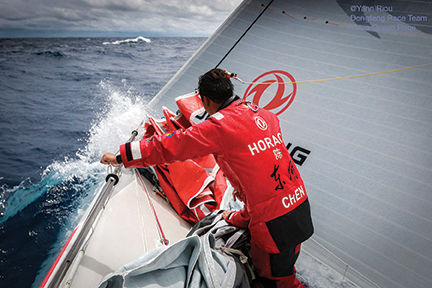
Jin Hao Chen ‘Horace’ on the bow pulling down the second headsail.
FIRST MILK RUN
The race started from Alicante, Spain on October 11, 2014 with the first leg a milk run to Cape Town, South Africa. Before entering the Atlantic the fleet had to negotiate the fickle winds of the Mediterranean and it was Team SCA that took first blood by leading through the Strait of Gibraltar. Once out into the Atlantic things became a bit more tricky with the finish positions in Cape Town determined early in the leg.
The biggest tactical obstacle facing the teams was the doldrums and Abu Dhabi Ocean Racing and Team Brunel decided early that they wanted to cross the windless zone to the west where the doldrums were the narrowest. They gave up the boost that you can get by taking advantage of the wind funneling between the Cape Verde islands and sailed some extra distance in return for their westerly position, but it paid off and the two boats were first into the trade winds.
“It was a no brainer for us to take the longer route,” explained Bouwe Bekking. “People like to say west is best and maybe there is something to it.”
Abu Dhabi managed to hold on to win the leg, but to everyone’s surprise the Chinese on Dongfeng finished in Cape Town just 12 minutes shy of Ian Walker and his team.
SHIPWRECK AND HARD SAILING
The real drama of the race took place on the leg from Cape Town to Abu Dhabi but first the sailors had to deal with a nasty low pressure system that threatened to split the fleet as the skippers chose different strategies for dealing with the tough conditions. The storm hit and with it came the predicted split as Mapfre, Abu Dhabi, Brunel and Dongfeng pulled well into the lead where they would stay for the rest of the leg. Their position at the back of the pack must have felt grim for Team Vestus Wind, but they would soon feel a whole lot worse.
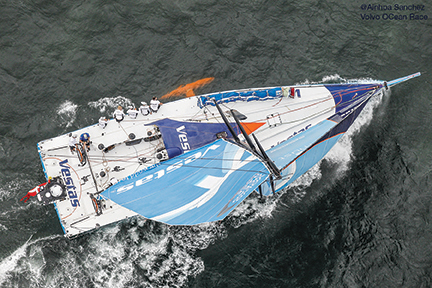
In the middle of the night, sailing in mild conditions, the boat grounded on the Cargados Carajos Shoals some 200 miles northeast of Mauritius. It was a heart stopping and heart breaking moment for the crew who were forced to abandon their boat. Luckily there were no injuries and a very comprehensive report on the accident that was later released explained what happened.
Section 122 read: “The simple cause of the stranding was that the crew was completely unaware of the presence of any navigational danger in the vicinity of the boat. Consequently no avoiding actions or precautions were taken that would have prevented the grounding. The Cargados Carajos Shoals were incorrectly thought to be safe to pass over and incorrectly thought to have a minimum charted depth of 40m.”
The shoals were marked on the electronic charts but they were only visible when you zoomed right in. A combination of fatigue from the storm and a lack of time to prepare in Cape Town plus numerous other smaller factors combined, and navigator Wouter Verbraak missed that crucial fact; he did not zoom in far enough. Team Vestus Wind was eventually salvaged, repaired and rejoined the race in Portugal, while Team Brunel won Leg 2 with Dongfeng again finishing a close second.
The Volvo Ocean Race course used to be a lot simpler but sponsor pressures demand that the race visit some out-of-the-way ports including Abu Dhabi and the Chinese port of Sanya. While this is great for sponsors, getting in and out of the Strait of Hormuz, negotiating the coast of India, sailing around Sri Lanka and across the Malacca Strait and into the South China Sea were all tactical nightmares for the sailors. Difficult sailing conditions combined with numerous fishing boats and tons of pollution made for some challenging sailing.
“It was the most intense night of sailing in my life,” confessed Charlie Enright shortly after entering the South China Sea. “We just completed probably our twelfth tack, among maybe seven thousand fishermen and three of our competitors.”
Before they could get to China, there remained a 1,000 mile upwind slog in short steep seas, but in the end it was the local team that took line honors. Any doubts that Dongfeng Race Team would not be a podium contender were long gone; they were atop the leader board with a one point lead over Abu Dhabi Ocean Racing.
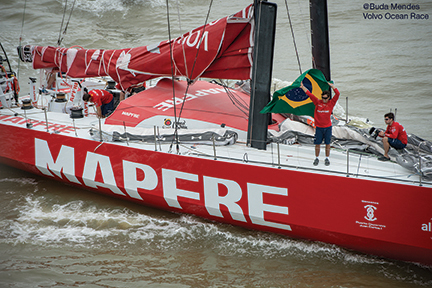
BATTLE OF THE DOLDRUMS
The fourth leg of the course started with an upwind slog as the fleet sailed up and over the Philippines from China. Francisco Vignale, onboard reporter for Mapfre, described the conditions. “It’s like rodeo bull riding,” he wrote. “We are still seasick, and trying to switch to sea mode.”
It would not be the last bit of nasty upwind work on the leg, but it was not so much the strong winds that gave the skippers and navigators pause, instead it was another crossing of the doldrums. The Dutch team led by Bouwe Bekking was leading the fleet having taken an early gamble. They were closely followed by Abu Dhabi with both skippers knowing all too well that the doldrums could be a game changer. Indeed it was as Brunel sailed into some dark clouds and came out the other side in fifth place. “From the penthouse to the outhouse,” was skipper Bekking’s honest assessment of the situation.
South of the equator, it was a straight-line drag race to New Zealand with very few tactics involved. Dongfeng had fought their way to the front of the fleet and were being closely followed by the Spanish team on Mapfre, but in a cruel twist squally weather close to the New Zealand coast allowed Mapfre to take the lead and also gave Abu Dhabi a break. By the time they crossed the finish line in Auckland Dongfeng had dropped to third. The Spaniards earned a well deserved victory while in the overall standings Dongfeng Race Team and Abu Dhabi Ocean Racing were tied with eight points apiece. It was, sadly, the last time that the Chinese would be in first place. Leg 5 had a nasty surprise in store for them.
ON TO THE HORN
Cyclone Pam forced the race organizers to delay the start of the only Southern Ocean leg. Three days after the scheduled start, the boats took off from New Zealand for Brazil but quickly sailed into the remnants of the cyclone. Matt Knighton on Abu Dhabi Ocean Racing described the conditions.
“Wind speed is around 30 knots right now and we’re doing around 20-22. It’s very bumpy onboard and loud from the waves crashing on deck. There are a few bouts of seasickness and we’re getting banged around a lot.”
Race officials had imposed strict adherence to numerous ice gates and with a westerly breeze the boats jibed downwind right along the edge of the ice limit. Sadly, 240 nautical miles west of Cape Horn, sailing in moderate conditions, the mast on Dongfeng snapped and with it their dream of a Volvo Ocean Race win. The mast broke just above the third spreader so the crew diverted to Ushuaia in southern Argentina to make repairs.
While the Chinese team was dealing with their bad news, the Americans on Alvimedica had good news as they were the first to round Cape Horn but their jubilation was short-lived. Conditions off the east coast of Argentina were horrendous as the sailors battled strong headwinds.
Alvimedica’s Amory Ross described the sailing. “We survived the Southern Ocean and Cape Horn only to get absolutely destroyed off the coast of South America. This will be the most uncomfortable, difficult, and dangerous 24 hours of the leg without question, while we hammer ourselves upwind into 35-40 knots in a completely confused and unpredictable sea.”
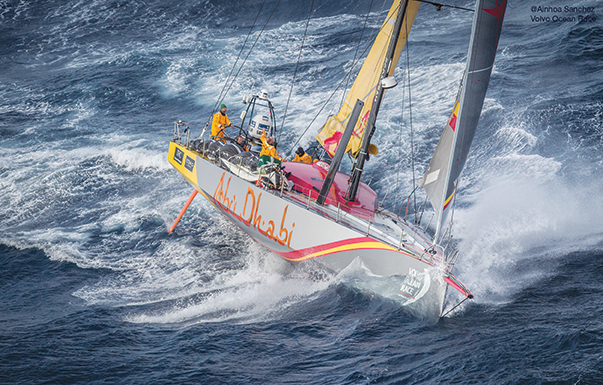
With their main rival Dongfeng temporarily out of the race Abu Dhabi started to sense an overall victory by winning the leg to Brazil and placing second into Newport. With just four legs remaining Abu Dhabi held a solid overall lead of five points over Dongfeng who reasserted themselves with a win into Newport. The dash across the Atlantic was going to be exciting.
FINAL CHAPTERS
With most of the race behind them it was still not clear who, if anyone would challenge Ian Walker for the winner’s trophy, or even who would make it onto the podium. It was still a tight race between Dongfeng, Brunel and Mapfre. Bekking and his boys on Brunel made a bold statement by winning the transatlantic leg into Lisbon but then things started to get interesting, a little choreography taking place.
Team Vestus Wind rejoined the fleet in Portugal with Chris Nicholson having replaced his navigator. Clearly they wanted to redeem themselves on the leg to Lorient, France, and redeem themselves they did. After finishing in last place on each previous leg, Team SCA seemed to find a extra gear and they led the fleet around some tricky tidal conditions off the coast of France to take a win in Lorient. In something you could not have scripted better, Team Vestus Wind came in second; redemption indeed.
With the final leg to Sweden looming, there must have been more than a few what-ifs. Three boats had been awarded a one-point penalty by sailing the wrong way in the Traffic Separation Schemes as they left Newport, Dongfeng among them. They would need a miracle to get second place overall but ended up almost losing third.
The miracle was instead handed to Team Alvimedica who won the last leg in fine style to take their first leg win of the race. But the real drama came in the fickle conditions close to the final finish line. Team Brunel finished second to take second place overall and a lucky puff pushed Mapfre ahead of Dongfeng. Had that lucky puff pushed them just a little harder and had they passed Brunel, Mapfre would have made the overall podium instead of Dongfeng. After a poor first leg, the Spaniards redeemed themselves with some excellent sailing, but a two point penalty after leg five for doing repairs and alterations on the hull without informing the Volvo Ocean 65 Class Authority, and a single point for the traffic separation zone violation off Newport allowed the Chinese to take third place overall.
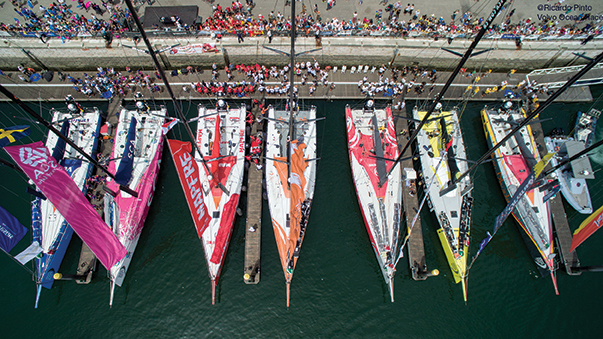
EPILOGUE
To be sure, the decision to go with one design boats was a good one and made for some incredibly close sailing. Boats crossing jibes just feet apart deep in the Southern Ocean is high drama for sure. The cost of an entry has been reined in and better yet these current boats will be good for the next race.
Consensus among veterans who had sailed the VOR 70s in previous races was that the one design boats were not as exciting to sail, but the racing was far more intense. It was a match race every inch of the way. The on-board reporters told the stories of “Life at the Extreme”, to use the VOR tagline, in a way that non-sailors understood and a whole new audience was drawn into the event.
Inmarsat, the company that provided satellite communication for the fleet, has hinted that there may be the possibility of live coverage all the way around the world for the next race. How intense would that be and for a guy, like myself, who did his first Whitbread in 1981 when the headsails had hanks and the only link to the outside world was a weekly single-sideband call, the idea of 24/7 coverage is thrilling. It’s a new, reinvigorated and better Volvo Ocean Race.
Brian Hancock is a sailmaker, author, lecturer and veteran offshore sailor and racer. He lives in Marblehead, Mass.

















